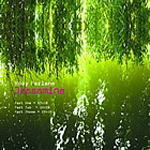|
|
 |
Dusted Reviews
Artist: Rosy Parlane Album: Jessamine Label: Touch Review date: Nov. 12, 2006 |

|
|
|
 |
New Zealander Rosy Parlane’s second effort for Touch embraces the broad outlines of music without conceding his orientation towards pure sound. Specifically, this record outs him as a child of rock; like Campbell Kneale (Birchville Cat Motel, Black Boned Angel), electric guitar racket is threaded into his artistic DNA, and here the strands push against the sonic surface until it bursts.
Jessamine comprises three unnamed tracks, as did Parlane’s last album Isis; both albums consist of carefully treated sounds stretched against the sort of continuous backdrop computers are so good at providing. But where Isis was as chill and light as its icy cover illustration, Jessamine feels earthy. And while the earth, like ice, moves slowly, it’s capable of much greater violence. “Part One” opens with a humming drone similar to Rafael Toral’s Wave Field and the last minutes of Sonic Youth’s “Xpressway To Yr Skull,” then accumulates scrapes and groans that wouldn’t sound out of place on a Mirror or AMM record. Parlane places and processes these sounds so carefully that you might not notice the natural progression from Prévost-like metallic protests to Neil Young-like feedback shrieks until it’s a fait accompli. “Part Two” has less movement but a bit more grain and grit, with crackling static bubbling up through the bright foundational drone like nighttime mist rising off the damp ground.
High-pitched digital flickers flit across the opening of “Part Three” like birds’ voices at the start of a new day. Then a violin rises in the mix, as though the listener was approaching a practicing Tony Conrad from around the hill, and the natural world yields to churning rock action. Throaty roars and fuzz tones accumulate, like cosmic matter flying into a black hole; eight guitarists, ranging from New Zealand vets Michael Morley and David Mitchell to noted non-guitarist Lasse Marhaug, bring the noise. And a glorious noise it is. But like all the best walls of sound, “Part Three’s” is not monochrome, but rich in seething details that burst through like newly-hatched winged beings anxious to fly. Rock on.
By Bill Meyer
|







